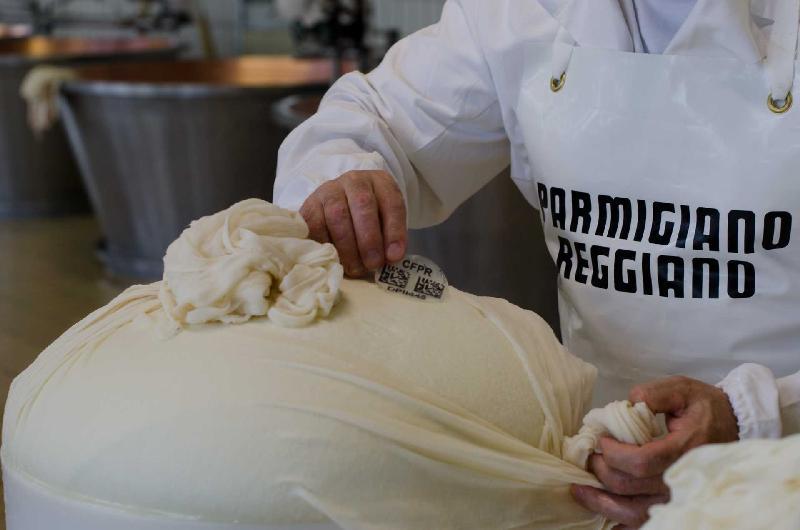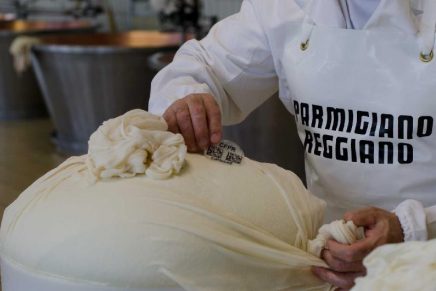Counterfeits are the bane of the Parmigiano Reggiano Consortium, which is now trialling tech in the rind. What Role Do Microtransponders Play in Parmesan’s Fight Against Imitations?

Cheese lovers worldwide can savor their Parmigiano Reggiano with newfound confidence, knowing that they are experiencing the real deal. @Parmigiano Reggiano Consortium/ @parmigianoreggiano.com
In the ever-evolving landscape of culinary craftsmanship and technological innovation, Parmigiano Reggiano is demonstrating how tradition and cutting-edge tech can converge to protect and preserve the integrity of one of Italy’s most cherished gastronomic treasures. Through the integration of microtransponders, the Parmigiano Reggiano Consortium is ensuring that every bite of Parmigiano Reggiano cheese carries with it not just the rich flavors of history and tradition but also the guarantee of authenticity.
Italy’s renowned Parmigiano Reggiano, often simply known as parmesan, is one of the most counterfeited cheeses in the world. Now, its manufacturers have adopted a novel strategy to combat these deceptive imitations: the integration of microchips, report The Guardian and Parmigiano Reggiano Consortium.
This initiative marks the latest innovative leap by the Parmigiano Reggiano Consortium (PRC), the association overseeing production. For over a century, they’ve battled against cheaper imitations that fall short of meeting the stringent requirements necessary to create the genuine article.
With a history that traces back to the Middle Ages, Parmigiano Reggiano received the coveted Protected Designation of Origin (PDO) status from the European Union in 1996. Under these regulations, Parmigiano Reggiano, the only cheese that can be called “parmesan” within Europe, must be meticulously crafted in a designated region in northern Italy, encompassing the provinces of Parma and Reggio Emilia.
The traceability of Parmigiano Reggiano has long been ensured by the casein plaque introduced by the Consortium in 2002. Each wheel of cheese receives a casein plaque at the moment of its creation. This plaque, composed of milk proteins and thus entirely edible and safe, bears a unique alphanumeric code and a QR code, serving as the cheese’s identity card. It enables anyone, anywhere, to trace its origin.
Kaasmerk Matec and p-Chip Corporation have joined forces to complete an innovation program, resulting in a p-Chip device integrated into the casein plaque. The innovation lies in the fusion of the casein plaque with the p-Chip microtransponder, a blockchain-like cryptotag creating a digital twin for physical objects. This new tag, scannable and smaller than a grain of salt, is highly durable and offers state-of-the-art traceability technology to the Parmigiano Reggiano Consortium.
“We are pleased to collaborate with a global leader like Parmigiano Reggiano to bring revolutionary, world-class tracking technology to the food industry,” said Joe Wagner, CEO of p-Chip Corporation. “By integrating p-Chip microtransponders into casein labels, the Parmigiano Reggiano Consortium can better control their inventory, protect and differentiate their products from similar brands, and gain access to unparalleled track-and-trace technology to safeguard against recalls or other issues. I look forward to working with the Parmigiano Reggiano Consortium to harness the full potential of this technology for their business.”
Over the past two years, the Parmigiano Reggiano Consortium has conducted extensive tests on the p-Chip/Kaasmerk Matec label in casein and has approved its technical use for the authentication and digital traceability of Parmigiano Reggiano.
“For over 100 years, we have collaborated with artisanal dairies to provide cheese marks made of casein, which invaluable safeguards their recipes, contributing to preserving the passion and craftsmanship they put into their cheese production,” said Winus Sloot, CEO of Kaasmerk Matec. “We are delighted to work with p-Chip to develop this digital smart label that will enable the tracking of Parmigiano Reggiano wheels from start to finish, ensuring further protection for both consumers and the Parmigiano Reggiano Consortium, as the label is highly tamper-resistant.”
These microchips represent the latest chapter in the cheese’s storied history, which dates back over a millennium to when it was first conceived by Benedictine and Cistercian monks in search of a long-lasting food staple.
Producers now contend that new technology is imperative, especially as exports of Parmigiano Reggiano to international markets continue to rise, with just under half of last year’s production making its way beyond Italy’s borders.
The digitization of the tracking process was designed to “convey the value of our product globally and distinguish it from similar-sounding products on the market that do not meet our strict requirements for production and area of origin,” stated PRC president Nicola Bertinelli.
The threat from knockoff varieties first surfaced after World War I, when a South American imitation called “reggianito” appeared on the market, created by Italian emigrants in Argentina. Last year, the PRC successfully blocked the US food giant Kraft Heinz from registering the “Kraft Parmesan Cheese” trademark in Ecuador, a victory of note, given that the EU’s PDO status is not recognized universally outside of Europe.




